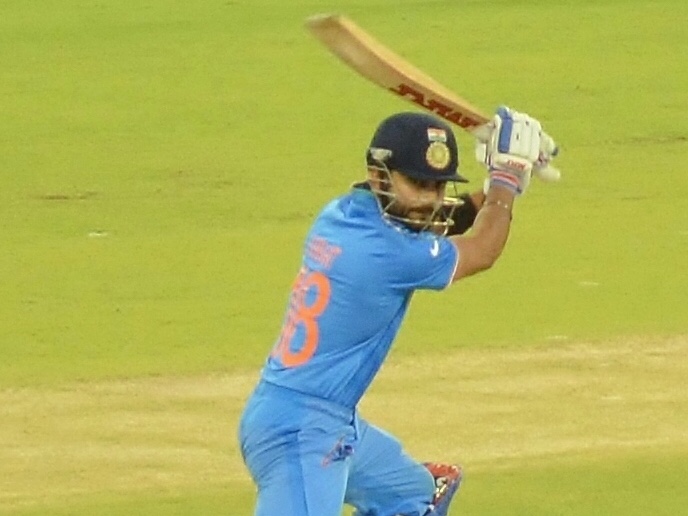How to Finish a Twenty20 Game Like Kohli
 Virat Kohli is an astonishing Twenty20 finisher. How does he do it?
Virat Kohli is an astonishing Twenty20 finisher. How does he do it?
What better way to find out that to examine one of his great innings in detail? Here is his brilliant 82 in the World T20 analysed. You can take the lessons from his method into your game.
Batting Tactics: How to Attack in Club and School Cricket
 In one day cricket, the tactic used to be to play yourself in early, knock the ball around in the middle overs and smash it at the end. Nowadays, the really powerful teams are able to attack throughout the innings.
In one day cricket, the tactic used to be to play yourself in early, knock the ball around in the middle overs and smash it at the end. Nowadays, the really powerful teams are able to attack throughout the innings.
Five Different Cricket Tactics to Try This Year
 Club and school cricketers are a conservative bunch. We like to play safe and stick to tried and tested tactics. But the game is changing fast, so isn't it time to try something new?
Club and school cricketers are a conservative bunch. We like to play safe and stick to tried and tested tactics. But the game is changing fast, so isn't it time to try something new?
Look the Part: How Your Image Makes You a Better Cricketer
 Here's an inconvenient truth: Your image is important to your cricket.
Here's an inconvenient truth: Your image is important to your cricket.
Naturally, results always come first. It doesn't matter what you look like if you are scoring hundreds then bowling out the opposition top six before catching the rest at slip. But if want a chance, you absolutely have to "look and act the part".
How to Captain: Placing the Fielders
This is part three of a series on how to captain in the field. To go to part one click here. To go back to the introduction click here.
Along with bowling changes, field placing is the other obvious part of captaincy in the field.
The simple way to look at it is to put the fielders where you think the ball is most likely to go (not always just where it has gone).
How do you do that without resorting to the stock fields that everyone uses?
Before we get into that, a word about orthodox fields: They are orthodox because they have been proven to work over the test of time. Slips remain in place because batsmen through the ages continue to edge the ball wide of the wicketkeeper. Mid on and mid off exist because even the most extreme Twenty20 specialists play shots with a straight bat sometimes.
That said it's important not to mindlessly follow what you consider the norm. Just because every captain in your club starts the game with a couple of slips, a gulley and a saving one field it does not mean you should.
For the basic theory of field placing take a look at my article here.
Once you have that in your mind, let's go back to the basic aim of field placing: Putting your players where you think the ball will go.
Six Shortcuts for Becoming an Excellent Batsman in Record Time
You’re impatient. You want success and you want it fast.
But batting is frustrating: You lack opportunities to practice and play in ways that help you improve. Even when you do get your chance you get a great ball first up and have to wait a week for another bat.
So here are six ways you can make to most of the chances you have and get ahead of the crowd to become a top-quality batsman in as short a time as possible.
1. Keep it Simple
Batting styles differ wildly, but one thing remains simple and true: Classy bastmen are world-class in the basics.
- They have a setup that keeps their head still, eyes level and move to the ball in good alignment.
- They are ready and focused on the ball as it is released.
- They have confidence in their game-plan.
So the first thing you need to look at is your setup, backswing and initial movement. Most people think they have it licked.
Spend time in the nets and be totally sure about it. Get someone to watch it or video yourself.
Where is you backlift going?
Are your eyes level?
Is your trigger move keeping you aligned?
To help, here is a worksheet to download and take to nets. Use deliberate practice and that sheet to start making a super quick difference.
Tactics You Should Be Using: Bowl at the Stumps
 Does it seem a bit old fashioned to say "pitch it up, hit the stumps"?
Does it seem a bit old fashioned to say "pitch it up, hit the stumps"?
In these days of slower ball bouncers, enforcers and bowling dry outside off stump you might think so. Actually, it's still an effective way to bowl in most situations.
Swing bowler on a slow English pitch in May? Yes.
Spinner on a Bunsen burner? Absolutely.
Fast bowler on a flat deck? Without doubt.
How to Use Hypnosis to Become Swashbuckling Madmen in Limited Overs Cricket

I saw a tweet this morning relating to the 4th ODI between England and NZ in the unbelievable ODI series.
Still not sure how a team goes from toilet to swashbuckling madmen in a few weeks. Hypnosis? Bionic implants? Quinoa? All of the above?
Change Your Format: Change Your Learning and Experiences

In a recent game, Millfield School scored 258-4 against Eton School's 107-7. Sounds like a one-sided game of limited overs cricket doesn't it? But this was far from the truth. This was declaration cricket. This was drama right up to the last ball.
Both coaches met before the game to discuss the format for the day. The pitch was a used one from a game earlier in the week. It was a good pitch, very dry and with patches of rough developing at both ends. We decided that there was potential for a declaration format to be played where bowlers, particularly the spinners, could have extended spells with no restrictions on field placement.
I was hoping that we won the toss as our spinners may have the opportunity to bowl with men around the bat; something that the limited overs a game rarely provides.
The game was on.
Let's examine why it was so good.
Avoid the "Moeen Ali Pickle" and Learn How to Play Spin

The ball spinning into the stumps at pace has always picked up wickets at a faster rate than the ball spinning away from the bat at pace. Wickets fall quickly unless batting methods are developed and honed.
In the England-West Indies Barbados Test, the bowlers foot holes developed quickly and the contest between spin and bat ultimately proved to be the defining factor in the contest.
Moeen Ali was batting against Permaul, the West Indies Left arm spinner, in England's 2nd innings. And as I watched I remembered something my first coach at school had told me.

